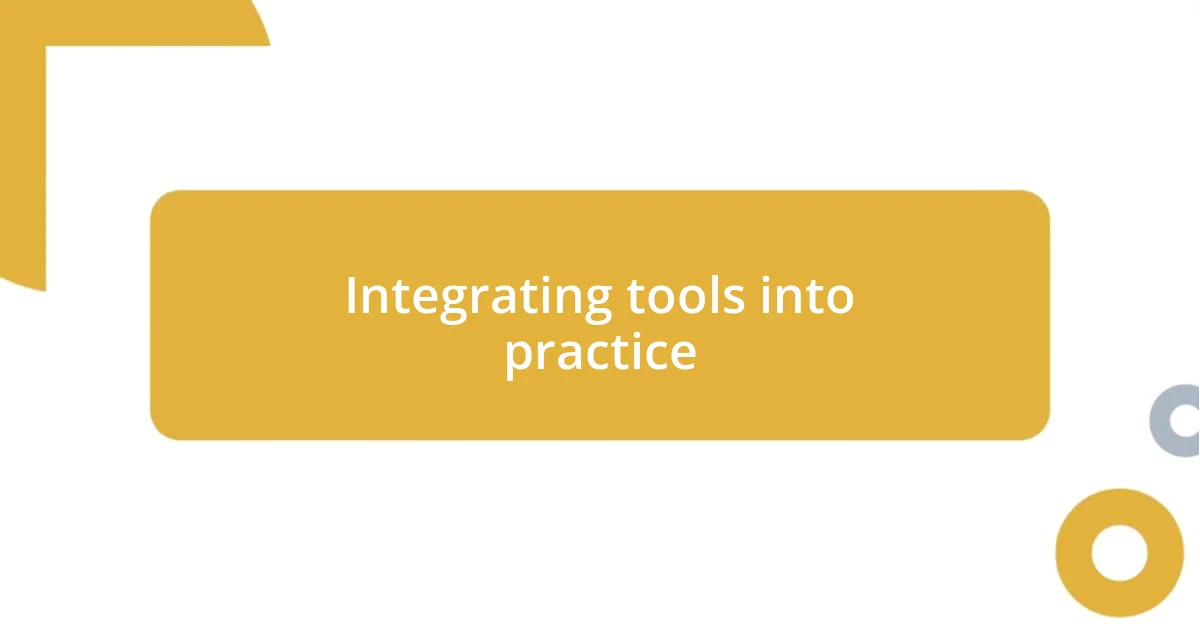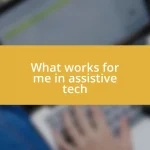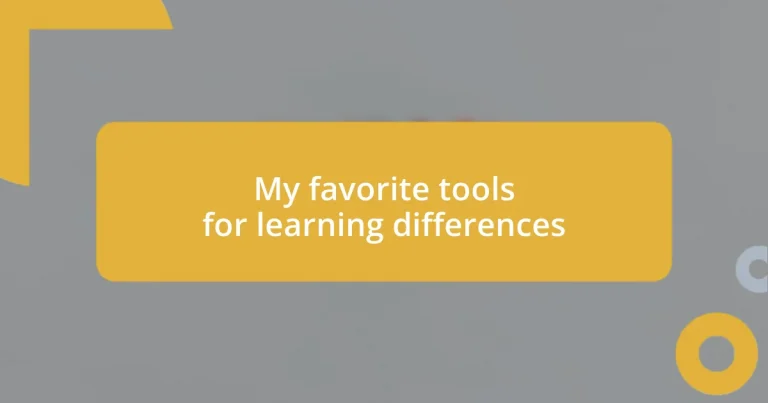Key takeaways:
- Understanding and embracing learning differences fosters inclusivity and enhances educational experiences for all learners.
- Effective learning tools must be user-friendly, flexible, engaging, provide feedback, and be accessible to cater to diverse learning styles.
- Assistive technology and hands-on approaches significantly empower learners, facilitating self-expression and deeper comprehension through active participation.

Understanding learning differences
Understanding learning differences is crucial because it helps us appreciate the unique ways individuals process information. I remember my first encounter with a learner who took longer to grasp concepts. At first, I felt frustrated, but I quickly realized that understanding their perspective changed everything. Have you ever noticed how your approach can shift once you see the world through someone else’s eyes?
Every learner is like a puzzle, with specific pieces that fit together differently. When I worked with a student who had dyslexia, I discovered how tailored strategies could illuminate their path to learning. It made me wonder—how many more students are out there, waiting for someone to unlock their potential with the right tools?
Recognizing these differences not only fosters an inclusive environment but also enriches our collective experience. I often ask educators what would happen if we celebrated these differences rather than viewing them as obstacles. The truth is, embracing diverse learning styles can lead to a more dynamic and creative educational journey for everyone involved.

Identifying effective learning tools
Identifying effective learning tools is about recognizing what works for individual learners. I’ve learned through my experiences that the right tool can make all the difference in facilitating understanding. For instance, I once introduced a student struggling with math to a visual learning app that transformed their engagement—suddenly, they were not just memorizing formulas but truly grasping concepts. It was a moment that reminded me of the immense power a tool can hold when aligned with a learner’s needs.
When considering which tools to incorporate, I often reflect on several key aspects:
- User-friendliness: Tools should be intuitive and easy for learners to navigate without frustration.
- Flexibility: Effective tools can adapt to various learning styles, whether visual, auditory, or kinesthetic.
- Engagement: The best tools capture attention, making learning feel less like a chore and more like an exploration.
- Feedback mechanisms: Tools that provide immediate feedback help learners adjust and grow in real-time.
- Accessibility: It’s vital that resources are available to all learners, regardless of abilities.
By keeps these points in mind, I feel more confident in selecting tools that genuinely resonate with different learners’ experiences.

Assistive technology for learning
Assistive technology plays a transformative role in learning, particularly for those with differing needs. I recall a moment in my teaching journey when I introduced speech-to-text software to a young girl with ADHD. Initially hesitant, she quickly realized she could express her thoughts without the struggle of handwriting. The joy in her eyes as she formulated beautiful ideas was a powerful reminder of how the right assistive technology can open doors to self-expression and understanding.
One of the remarkable aspects of assistive technology is its versatility. While some students benefit from audiobooks that bring literature to life, others may thrive with graphic organizers that help them visualize complex concepts. I remember working with a student who struggled with essay writing; using a mind-mapping tool, he could see his thoughts laid out clearly and organize his ideas effectively. The smiles of achievement he shared showed me firsthand how these technologies can really empower learners.
Moreover, it’s essential to continuously evaluate how these tools impact learning experiences. For instance, I often ask myself if a tool not only meets academic needs but also fosters a sense of confidence and independence in my students. I’ve seen learners blossom when they use technology that resonates with their unique abilities. This not only enhances their educational journey but also cultivates a belief that they can succeed, no matter the challenges they face.
| Assistive Technology | Description |
|---|---|
| Speech-to-Text Software | Allows learners to convert spoken language into written text, promoting self-expression. |
| Audiobooks | Provides verbal access to literature, aiding comprehension and engagement. |
| Graphic Organizers | Visually represents information to help learners organize their thoughts and ideas. |
| Mind-Mapping Tools | Supports brainstorming and outlining by visualizing relationships between concepts. |

Tools for visual learners
Visual learners thrive on imagery and color, so crafting an environment rich in visuals can dramatically enhance their understanding. I remember a student who really struggled with vocabulary; once we used flashcards with vibrant images alongside the words, his retention soared. It was fascinating to see how the visual cues transformed abstract concepts into something tangible and relatable for him.
There are a plethora of tools designed specifically for visual learners. For example, I’ve had great success using interactive diagrams and infographics, which can distill complex subjects into clear visuals. In one instance, I utilized an online platform that allowed my students to create their own infographics. Watching them synthesize information into creative visuals not only deepened their understanding but also sparked their enthusiasm for the material.
I often wonder, how can we make learning even more engaging for visual learners? In my experience, incorporating videos and animations can be a game changer. One time, while teaching about ecosystems, I showed an engaging documentary clip, and suddenly, the classroom buzzed with excitement. Students were not just passive viewers; they became active participants, asking questions and sharing ideas. This level of engagement reaffirmed my belief in the importance of utilizing visual tools to unlock a world of learning possibilities.

Tools for auditory learners
Tools designed for auditory learners can truly change the way information is absorbed and retained. I once worked with a student who found it difficult to focus during traditional lectures. By integrating podcasting tools into our curriculum, he discovered a whole new motivation to learn. Hearing experts discuss topics he was passionate about sparked his interest and made him more proactive in class discussions, illustrating the profound impact of auditory resources.
Another fantastic resource is language learning apps that utilize auditory cues. I remember when a client struggled with foreign language pronunciation; we turned to an app that featured native speakers. Listening to their tones and accents improved his confidence immensely. It made me realize how the simple act of listening can bridge gaps in learning and foster a deeper connection to new languages.
Lastly, I often reflect on the use of sound-based mnemonics in my teaching practice. These rhymes and rhythms can effectively lock information into memory. Once, during exam season, I had students create their own songs about mathematical concepts, which transformed stressful studying into a lively and memorable experience. It raised an important question for me: Why don’t we lean more on what engages our ears to enhance understanding? I’ve seen firsthand how auditory tools can make learning relatable and enjoyable, reinforcing my belief in the power of sound in education.

Tools for kinesthetic learners

Tools for kinesthetic learners
When it comes to kinesthetic learners, hands-on activities can be transformational. I once taught a science unit on the solar system and decided to have my students build their own models out of various materials. The joy on their faces as they glued together cardboard planets was palpable. Watching them not only grasp the concepts but also connect with the content on such a tangible level was incredibly rewarding. Isn’t it fascinating how building something can enhance cognitive understanding?
Incorporating movement into learning can also be highly effective. I remember using a game that involved physically rearranging words to form sentences. The students were literally jumping up to grab words from a pile, and it turned learning into an active adventure. This method ignited a lively atmosphere; suddenly, learning felt less like a chore and more like an exhilarating challenge. How often do we consider the physical aspect of learning in our lesson plans?
Another powerful tool is the use of manipulatives, like blocks or puzzles, for problem-solving in mathematics. I learned this firsthand when I introduced base-ten blocks to my class. The moment my students physically grouped these blocks to understand addition and subtraction, their comprehension deepened. It struck me how invaluable it is to let kids touch, move, and play with concepts. It leaves a lasting impression—how effective can movement be in solidifying knowledge, I wonder?

Integrating tools into practice
Integrating tools for kinesthetic learners into practice can be a game-changer. I vividly recall a workshop I led where we used playdough to teach geometric shapes. As the participants molded and manipulated the dough, their laughter filled the room, and their understanding blossomed. It was clear to me that when learning becomes a physical activity, it transforms the experience into something joyful and impactful. Isn’t it remarkable how tactile engagement can create lasting memories?
Moreover, incorporating technology can enhance hands-on learning experiences. In one project, I introduced virtual reality stations where students could explore anatomy by virtually dissecting a frog. The excitement on their faces reflected their newfound appreciation for the subject. I often ponder how much more immersive learning can be when we use innovative tools to enhance traditional methods. What if every lesson could tap into that level of engagement?
Additionally, I’ve noticed the power of collaborative projects where students build group models or create skits. During one such group activity, the students designed a miniature ecosystem; the camaraderie and teamwork fueled their creativity. Seeing them brainstorm, laugh, and learn together made me appreciate the social aspect of kinesthetic learning. It begs the question: how can we further leverage collaboration to enrich learning experiences?











